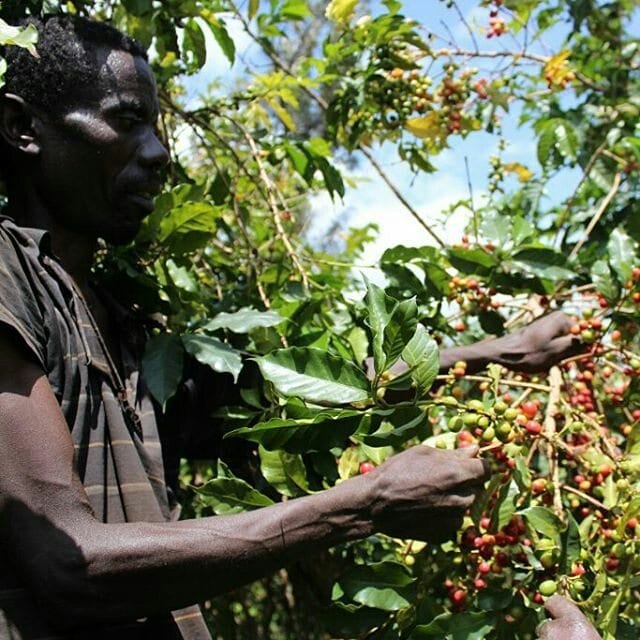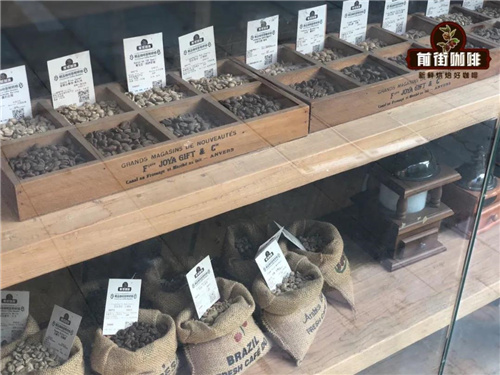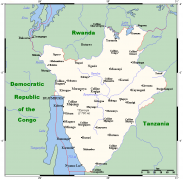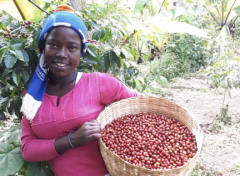Does the growing environment of Daquan coffee affect the quality and flavor of coffee beans growing countries and producing areas in the world?
Coffee from around the world.
The ideal conditions for growing coffee trees are found all over the world, in the equatorial zone between 25 degrees north latitude and 30 degrees south latitude, known as the "bean belt."
Finicky Arabica coffee grows best in fertile soil at high altitudes, while healthier Robusta coffee prefers higher temperatures and can thrive on lower ground.

What affects coffee quality and flavor?
Everything from the type of plant, the chemical composition of the soil, the weather, the amount of rainfall and sunlight, and even the precise altitude at which coffee grows affects the taste of the final product.
These key variables, combined with the way cherries are processed after picking, help differentiate coffees from countries, growing regions and plantations around the world.
The combination of factors is so complex that even from a single plantation, one can find differences in quality and taste.

Coffee is grown in more than 50 countries worldwide, including:
North America and the Caribbean
United States-Hawaii
Although coffee farms are scattered throughout the Hawaiian Islands, Kona coffee from Hawaii's Big Island is best known and in constant demand. Here, nature provides just the right environment for coffee trees on the slopes of the active Mauna Loa volcano. Young trees are planted in black volcanic soil, so new that farmers often seem to plant seedlings in rocks. Tropical clouds form a natural canopy over trees in the afternoon shade to protect them from intense sunlight, while frequent island showers provide just the right amount of rain for plants. Kona coffee is carefully processed to create a delicious, rich, aromatic medium bodied cup.
Mexico
Small coffee farms are more common than large plantations in Mexico, but Mexico has more than 100,000 coffee farmers and is one of the largest coffee producers in the world. Most farms are located in the southern states of Veracruz, Oaxaca and Chiapas. A cup of Mexican coffee usually has a wonderful aroma and rich flavor, usually with a distinct sharpness. It is an excellent dark roasted coffee bean that is often used in blends. Mexican coffee is named Altura because it grows at high altitudes.
Puerto Rico
Coffee was brought to Puerto Rico from Martinique in 1736, and by the late 19th century the island had become the world's sixth largest coffee exporter. However, major hurricanes and competition from other coffee-producing countries forced the island to seek alternative economic survival. Today, the coffee industry is undergoing a renaissance, using coffee carefully cultivated from premium Arabica varieties produced to the highest standards. There are two main growing areas in the Caribbean islands: Grand Lares in the south-central region and Yauco Selecto in the south-west. Both regions are known for the balanced taste and acidity of their coffee beans, as well as the fruity aroma.
Central America
Guatemala
While perhaps not as well known as some of its Central and South American neighbors, Guatemala coffee has unique taste qualities that are favored by many for its intense flavor. The three main growing regions-Antigua, Coban and Huehuetanango-each boast breathtaking rugged landscapes and fertile volcanic soils. Microclimate strongly affects the quality and flavor of "strict hard beans"(grown at altitudes of 4500 feet/1370 meters or more). This medium to full-bodied coffee has a rich and complex flavor, almost spicy or chocolate.
Costa Rica
Costa Rica produces only wet-processed Arabica coffee. Medium-bodied and intense acidity, usually described as perfectly balanced. Costa Rican coffee is mainly grown on small farms or fincas. Immediately after harvest, cherries are sent to state-of-the-art processing facilities beneficios, where wet processing begins. Careful attention to quality processing and careful cultivation methods has given Costa Rica a reputation for fine coffee.
South America
Colombia
Colombia is probably the most famous coffee producer in the world, ranking second globally in terms of annual production. Thousands of small family farms across the country are proud to maintain high standards of excellence. Such care and attention produces consistently good coffee, mild coffee, and balanced acidity. Colombia's rugged terrain provides the perfect natural environment for cultivation, but the terrain makes it difficult to transport harvested coffee beans to production and transportation centers. Even today, this is usually done by mule or jeep. The highest grade, Colombia Supremo, has a delicate, aromatic sweetness, while the Excelso grade is softer and slightly acidic.
Brazil
Brazil is the world's largest coffee producer, and its production range seems endless. Coffee plantations in Brazil typically cover large areas of land and require hundreds of people to manage and operate them to produce large quantities of coffee. Arabica and Robusta are both grown, and climate, soil quality and elevation determine which varieties grow best in which areas. A fine glass of Brazilian wine is clear, sweet, medium-bodied and low in acidity.
East Africa
Ethiopia
Coffee legend tells the story of the discovery of the first coffee tree in Ethiopia-it's not hard to believe coffee originated where wild coffee tree forests are still the main source of harvest. Coffee from Ethiopia is usually wet-processed, comes from one of the three main growing regions-Sidamo, Harar, Kafa-and is usually named after one of them. In the cup, Ethiopian coffee tends to offer an extraordinary and bold statement: full-bodied, slightly grounded, and full-bodied.
Kenya
Kenyan coffee is famous and popular both in the United States and Europe. Beans produce intense fruity acidity, combined with a full body and intense aromas. Coffee is grown in the foothills of Kenya and is usually grown by small farmers. Kenyan producers value quality and therefore the processing and drying procedures are carefully controlled and monitored. Kenya has its own unique classification system. Kenya AA is the largest bean in the 10 grading system, AA+ means it is plantation grown.
West Africa (West Africa)
Ivory Coast
Ivory Coast is one of the world's largest producers of Robusta coffee, which is rich in aroma, light in body and high in acidity. This variety is very suitable for deep roasting, so it is often used to blend espresso coffee.
Arabian Peninsula
Yemen
In the countries where coffee was first grown commercially, coffee is still grown in ancient, centuries-old ways. In a small terraced garden on a family farm, you will almost always find a few coffee trees. Because water is scarce in this arid land, coffee beans grown here tend to be smaller and more irregular in size and shape. A lack of water also means coffee cherries will be dried after harvest. The result is Yemeni coffee with a distinctive flavor, deep, rich and distinctive.
In ancient times, the word mocha became synonymous with Arabic coffee when coffee was shipped from the famous Yemeni mocha port to all parts of the world. The Dutch combined Arabica coffee with coffee grown on Java to create the first coffee mixture-still known today as mocha java.
Asia
Indonesia
Indonesia is one of the largest countries in the world and consists of thousands of islands. Several of the larger islands-Sumatra, Java and Sulawesi-are world renowned for their quality coffee. In the 17th century, Dutch colonists introduced coffee plants to Indonesia, and the country soon led the world in production. Today, small coffee farms of 1-2 acres dominate, most of them dry processed. Indonesian coffee is known for its rich, intense and mild acidity.
Indonesia is also known for its premium aged coffee, which farmers hold for a while in hopes of selling at a higher price. In Indonesia's warm, humid climate, storage gently ages coffee, making it richer in taste and less acidic. Even with today's technology, this process is unmatched.
Vietnam
Coffee was first introduced to Vietnam in the mid-19th century when French missionaries brought Arabica trees from Bourbon Island and planted them near Tokyo. Coffee has recently been reintroduced and the coffee industry is growing so rapidly that Vietnam is rapidly becoming one of the world's largest producers. Today, small plantations located in the southern half of the country mainly produce Robusta coffee. Vietnamese coffee is light in acidity, warm in body temperature, well balanced and often used for blending.
Other coffee-producing countries include:
Angola
Ecuador
Liberia
Rwanda
Bolivia
El Salvador
Madagascar
Sierra Leone
Burundi
Ethiopia
Malawi
Tanzania
Cameroon
Gabon
Nicaragua
Thailand
Central African Republic
Ghana
Panama
East Timor
China
Guinea
Papua New Guinea
Togo
Cote d'Ivoire
Haiti
Paraguay
Uganda
Cuba
Honduras
Lao people's Democratic Republic
Venezuela
Democratic Republic of the Congo
India
Peru
Zambia
Dominican Republic
Jamaica
Philippines
Zimbabwe
Important Notice :
前街咖啡 FrontStreet Coffee has moved to new addredd:
FrontStreet Coffee Address: 315,Donghua East Road,GuangZhou
Tel:020 38364473
- Prev

Brief introduction of Burundian Coffee producing area of Starbucks Coffee beans Burundian Coffee History and unique washing treatment
Burundi has favorable conditions for growing coffee at different elevations throughout the country. The lowest point is in Lake Tanganyika in the west, 772m above sea level, and the highest point is at the top of Mount Heha, 2670 m above sea level. As a result, most coffee is strictly SHG and SHB, and most coffee beans grow at an altitude of about 1200-2000 meters. Besides, the perfect coffee
- Next

Legend of the Origin of Coffee in Ethiopia: how do Yega Xuefei Dingding Coffee beans taste?
Many coffee lovers regard Ethiopian coffee as their favorite. In their eyes, the fruity and floral Ethiopian coffee beans are always the winners. There is no doubt that for many years, Ethiopian coffee has been the most acclaimed coffee bean in a single producing area in the world. As the world's fifth largest coffee producer, Ethiopia has mastered the art of harvesting and processing coffee beans.
Related
- Detailed explanation of Jadeite planting Land in Panamanian Jadeite Manor introduction to the grading system of Jadeite competitive bidding, Red bid, Green bid and Rose Summer
- Story of Coffee planting in Brenka region of Costa Rica Stonehenge Manor anaerobic heavy honey treatment of flavor mouth
- What's on the barrel of Blue Mountain Coffee beans?
- Can American coffee also pull flowers? How to use hot American style to pull out a good-looking pattern?
- Can you make a cold extract with coffee beans? What is the right proportion for cold-extracted coffee formula?
- Indonesian PWN Gold Mandrine Coffee Origin Features Flavor How to Chong? Mandolin coffee is American.
- A brief introduction to the flavor characteristics of Brazilian yellow bourbon coffee beans
- What is the effect of different water quality on the flavor of cold-extracted coffee? What kind of water is best for brewing coffee?
- Why do you think of Rose Summer whenever you mention Panamanian coffee?
- Introduction to the characteristics of authentic blue mountain coffee bean producing areas? What is the CIB Coffee Authority in Jamaica?

